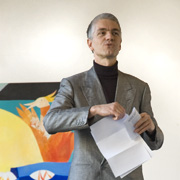 Inaugural address to the exhibition in Schlangenbad on 4 March 2007
Inaugural address to the exhibition in Schlangenbad on 4 March 2007
Detlev Sieber, retired mayor of Schlangenbad:
” Dear Ladies and Gentlemen, dear Friends of the Communal Gallery!
What is most striking in the paintings of Anna Bieler, which are shown in this new exhibition, are their powerful colouring. Coolly glowing primary colours, which are mostly mixed and toned with white colour so that the colours become even more bright and pastel.
In purely physical terms we know that our whole differentiated realisation of colours is based on these primary colours, but paradoxically they behave contradictory to our natural viewing habits when we see them separately and not mixed with each other, particularly as they do not occur in nature with this unbroken clarity. There are examples for the use of these brilliant primary colours in recent history of art, for instance in the expressionism of the early 20th century, in the German Bauhaus movement, and in pop art.
In all these art styles, the purpose of the “colourful“ colours was always the same: Reduction to the primary colours was supposed to create a new clarity, and the large, simply-structured coloured surfaces add power to the paintings. Upon a closer look it can be seen that the coloured surfaces of Anna Bieler’s paintings are not at all flat and too conspicuous. Her painted surfaces develop a life of their own. Among other things, this can be seen from the fact that the whole surface, until the edge to the next coloured surface, is thoroughly painted with a small brush and is structured in itself. Anna Bieler interprets the sort of unnatural colouring of her paintings as a spiritual element, as a counterpart to the material world. For her, paintings such as “Im Paradies” (“In Paradise”), “Die Wache” (“The Sentinel”) or “Göttin in Blau” (“Goddess in Blue”) are paintings of power that show with their large formats that “Colours are energy”. Anna Bieler grew up in Greece and Portugal where her parents worked as teachers at the German School. Her childhood in those Southern countries strongly influenced her, and she calls herself a „child of the sea and the sun“. She used to swim in the sea a great deal and spent almost more time under water than above. In this way she internalised the feeling of weightless floating that is reflected in her paintings.
For Anny Bieler water is a synonym for the subconscious to which she associates a certain feeling. The recurring depiction of a fish stands for her personal experiences that the fish epitomises as the primordial animal of our world. The fish seems to float without weight in the same way Anna Bieler experienced and felt as a child in the water. In Anna Bieler’s imageries the fish does not only float in the water, but also through the air.
The bird is the counterpart to the fish: It can really float, and it represents an even more distinct weightlessness. In Anna Bieler’s imageries the bird embodies freedom, the overcoming of the material and at the same time the spiritual, bodyless element.
The small-format picture ”Entzweit“ (“Disunited”) is a good example where this core of Anna Bieler’s own symbolism can be detected. Anna Bieler makes a statement: She paints a fish and a bird in front of a globe that is breaking – symbol of the corporeal world. It is up to the viewer to develop this situation into a story …
The animals painted by Anna Bieler are no real animals, but rather mythical creatures. In her paintings, Anna Bieler deals with mankind, with our dreams, with the visualisation of the subconscious. It is Anna Bieler’s intention that the viewer finds himself in her paintings, and she wants to lead mankind back to itself. In the centre of most of Anna Bieler’s paintings human faces are therefore presented as schemes. Sometimes they do not have noses (for instance in “Mother Martha”), but it is astonishing how these abstractions make it easier for the viewer to identify himself with the picture.
In order to be able to create huge, clear surfaces, an idea, a perception, a statement is needed from the very beginning. Sometimes Anna Bieler starts with a form, for example she confronts herself with the task to paint an extensive face that at the same time fills the whole large format. Frequently she also approaches her paintings from the contents. Many of her paintings, for example, involve the subject “relationship between man and woman”.
Many of the scenes painted by Anna Bieler are subtle, humorous and funny – not matter if they show the negation of gravity, flying cherries and pears, full bosoms or, if we look at the picture “In Paradise”, the yellow face of the newly created human being who in all his platitude and simple-mindedness will soon be taken in by the snail already lurking in the background. However, the pictures of Anna Bieler are not only characterised by this obvious ease and cheeriness. Anna Bieler paints dreams, and dreams are not always cheerful. The dark side of mankind is involved, for example, in the paradise a mask-like figure with blazing flames in its eyes is standing next to the innocent face. And on a closer look, not only dark contents full of tensions can be sometimes detected, but the brightly shining colours are in contrast with heavy and dark shades, too, sometimes even reaching rich black. For Anna Bieler this dark side must be present and is reflected in her paintings by the technical aspect, i.e. in dark colour surfaces, as well as by dark allusions of her imageries.